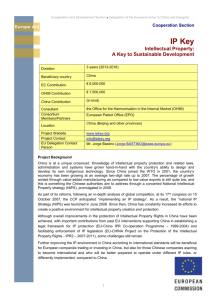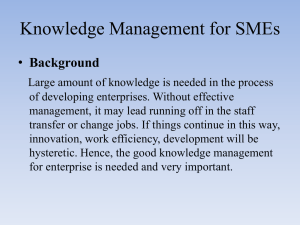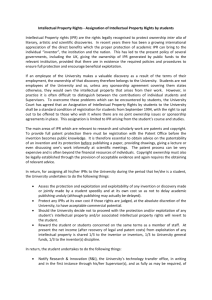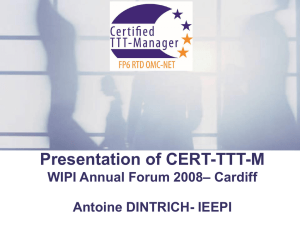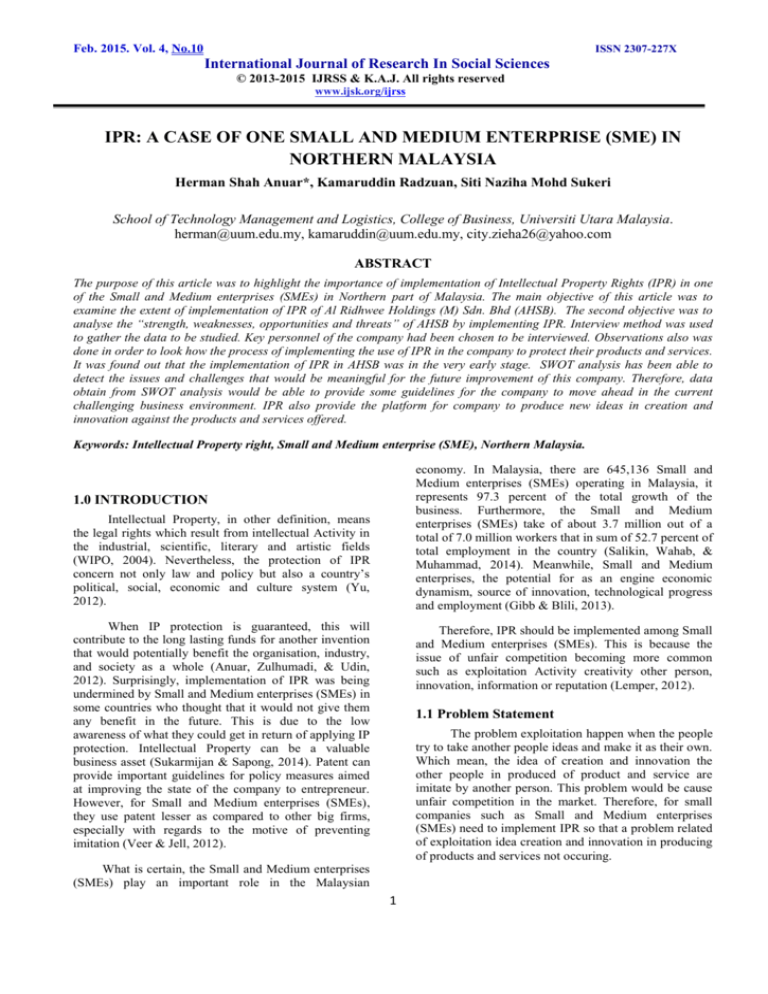
Feb. 2015. Vol. 4, No.10
ISSN 2307-227X
International Journal of Research In Social Sciences
© 2013-2015 IJRSS & K.A.J. All rights reserved
www.ijsk.org/ijrss
IPR: A CASE OF ONE SMALL AND MEDIUM ENTERPRISE (SME) IN
NORTHERN MALAYSIA
Herman Shah Anuar*, Kamaruddin Radzuan, Siti Naziha Mohd Sukeri
School of Technology Management and Logistics, College of Business, Universiti Utara Malaysia.
herman@uum.edu.my, kamaruddin@uum.edu.my, city.zieha26@yahoo.com
ABSTRACT
The purpose of this article was to highlight the importance of implementation of Intellectual Property Rights (IPR) in one
of the Small and Medium enterprises (SMEs) in Northern part of Malaysia. The main objective of this article was to
examine the extent of implementation of IPR of Al Ridhwee Holdings (M) Sdn. Bhd (AHSB). The second objective was to
analyse the “strength, weaknesses, opportunities and threats” of AHSB by implementing IPR. Interview method was used
to gather the data to be studied. Key personnel of the company had been chosen to be interviewed. Observations also was
done in order to look how the process of implementing the use of IPR in the company to protect their products and services.
It was found out that the implementation of IPR in AHSB was in the very early stage. SWOT analysis has been able to
detect the issues and challenges that would be meaningful for the future improvement of this company. Therefore, data
obtain from SWOT analysis would be able to provide some guidelines for the company to move ahead in the current
challenging business environment. IPR also provide the platform for company to produce new ideas in creation and
innovation against the products and services offered.
Keywords: Intellectual Property right, Small and Medium enterprise (SME), Northern Malaysia.
economy. In Malaysia, there are 645,136 Small and
Medium enterprises (SMEs) operating in Malaysia, it
represents 97.3 percent of the total growth of the
business. Furthermore, the Small and Medium
enterprises (SMEs) take of about 3.7 million out of a
total of 7.0 million workers that in sum of 52.7 percent of
total employment in the country (Salikin, Wahab, &
Muhammad, 2014). Meanwhile, Small and Medium
enterprises, the potential for as an engine economic
dynamism, source of innovation, technological progress
and employment (Gibb & Blili, 2013).
1.0 INTRODUCTION
Intellectual Property, in other definition, means
the legal rights which result from intellectual Activity in
the industrial, scientific, literary and artistic fields
(WIPO, 2004). Nevertheless, the protection of IPR
concern not only law and policy but also a country’s
political, social, economic and culture system (Yu,
2012).
When IP protection is guaranteed, this will
contribute to the long lasting funds for another invention
that would potentially benefit the organisation, industry,
and society as a whole (Anuar, Zulhumadi, & Udin,
2012). Surprisingly, implementation of IPR was being
undermined by Small and Medium enterprises (SMEs) in
some countries who thought that it would not give them
any benefit in the future. This is due to the low
awareness of what they could get in return of applying IP
protection. Intellectual Property can be a valuable
business asset (Sukarmijan & Sapong, 2014). Patent can
provide important guidelines for policy measures aimed
at improving the state of the company to entrepreneur.
However, for Small and Medium enterprises (SMEs),
they use patent lesser as compared to other big firms,
especially with regards to the motive of preventing
imitation (Veer & Jell, 2012).
Therefore, IPR should be implemented among Small
and Medium enterprises (SMEs). This is because the
issue of unfair competition becoming more common
such as exploitation Activity creativity other person,
innovation, information or reputation (Lemper, 2012).
1.1 Problem Statement
The problem exploitation happen when the people
try to take another people ideas and make it as their own.
Which mean, the idea of creation and innovation the
other people in produced of product and service are
imitate by another person. This problem would be cause
unfair competition in the market. Therefore, for small
companies such as Small and Medium enterprises
(SMEs) need to implement IPR so that a problem related
of exploitation idea creation and innovation in producing
of products and services not occuring.
What is certain, the Small and Medium enterprises
(SMEs) play an important role in the Malaysian
1
Feb. 2015. Vol. 4, No.10
ISSN 2307-227X
International Journal of Research In Social Sciences
© 2013-2015 IJRSS & K.A.J. All rights reserved
www.ijsk.org/ijrss
The next problem is the use of IPR is not
widespread among Small and Medium enterprises
(SMEs). Most of the entrepreneur in Small and Medium
enterprises (SMEs) is not aware of IPR. Therefore, they
take for granted on the implementation of IPR. However,
they do not know that IPR can provide protection for
creation, brands and designs products and services and
can provide financial benefits or rewards to inventors or
creator.
enterprises (SMEs) in Northern Malaysia. Among the
important of this study are:
2.0 LITERATURE REVIEW
2.1 Intellectual Property
Intellectual Property, very broadly, means the legal
rights with result from Intellectual Activity in the
industrial, scientific, literary and artistic field (WIPO,
2004) through the result this Activity will be protected in
the various branches such as Patents, Copyrights,
Trademarks, Industrial Designs, geographical indications
and trade secrets (Palmqvist, Sandberg & Mylly, 2012).
In Malaysia, these Activities will be covered under the
law, such as Patents, Trademarks, Copyrights, Industrial
Designs, geographical indications and layout designs of
integrated circuits (MyIPO, 2008). However, there are
presumption of differ in meaning and concepts of IPR
from developed countries such as the United States and
Russia. The United States considers the Intellectual
Property as a form of personal property and can be
exploited by the owners namely can be used by the
owner, selling or market. Presumption Intellectual
Property of the Russian state is something intangible and
produced through Intellectual Activity such as creation,
innovation, know-how and etc ( Mingaleva & Mirskikh,
2013).
Besides that, the problem found in this study is the
issue of counterfeiting and piracy. The issue of
counterfeiting and piracy of products and services can be
harm to the commerce and welfare of the people and
undermine confidence in the quality of brand name
product and service which will lead to the lost of
revenue, investment, future sales and growth
opportunities business. It is also detrimental to the
business and employees that play an important role in the
design, manufacture, distributiion and selling original
products.
1.2 Objectives of Research
This research is about the implementation IPR (IPR)
among Small and medium enterprises (SMEs) in
Northern Malaysia. There are several objectives of this
study:
In the business, Intellectual Property is the most
important asset in business (Lemper, 2012). This is
because, the Intellectual Property system could be
providing of guideline to entrepreneurs to policy
measures which aimed at improving the business
environment (Veer & Jell, 2012). At the global level, the
use of IPR has become a major concern for harmony in
the market, especially in countries transition such as
China (Qing, 2014).
a)
To examine the extent of implementation
of IPR of AHSBCompany.
b) To analyze the Strength, Weaknesses,
Opportunity,
and
Threat
of
AHSBCompany by implementing IPR.
This research is expected to serve as a prelude for further
study.
Besides that, the Intellectual Property becomes
important thing for entrepreneurs to ensure a competitive
advantage in business. The importance of Intellectual
Property protection such as Patents become more
important because the rapid technology development in
specific areas. The market there is always a new product,
process marketing innovation that arise consequent from
the needs of customer which ongoing. Therefore,
companies should use the Intellectual Property in the
innovation cycle in order to avoid the problem of high
losses in the business (Rylkova & Chobotova, 2014).
1.4 Scope of Research
This study was only focusing on one of the Small and
Medium enterprises (SMEs) in Northern Malaysia. This
company is known as Al Ridhwee Holding (M) Sdn Bhd.
AHSBwhich is famous with the production of "Kuih
Loyang Madu". This study includes description to what
extent the implementation of IPR of Al Ridhwee Holding
(M) Sdn Bhd.
1.5 Significance of Research
The next, Intellectual Property has many branches of
Patents, Copyrights, Trademarks, Industrial Designs,
geographical indications and trade secrets (Palmqvist,
Sandberg & Mylly, 2012).
Through this study, it can provide an overview and
guidelines for researchers to understand IPR. Meanwhile,
this study can also provide benefits to researchers
regarding approaches to the study. Therefore, this study
is so important for future research about the
implementation of IPR among Small and Medium
2
Feb. 2015. Vol. 4, No.10
ISSN 2307-227X
International Journal of Research In Social Sciences
© 2013-2015 IJRSS & K.A.J. All rights reserved
www.ijsk.org/ijrss
2.1.1 Patents
2.1.4 Industrial design
Patent is a document, issued, upon application by
the government officials representing several countries.
Patent describes invention and creates as a law that can
be exploited as produced, used, sold and imported by the
owner Patent. Patent is the creation that cannot be
utilized by anyone other than the owner. This indirectly
helps the owner to prevent others from exploiting the creation
commercially (WIPO, 2004).
Industrial Design refers to creative activities to achieve
the ornamental appearance for mass-produced items,
within the available cost constraints, satisfies both the
need for the item to appeal visually to potential
customers. In terms of law, Industrial Design refers to
the rights granted in many countries, according pursuant
to a registration system; protect the original ornamental
and non-functional features of an industrial article or
product from design activity. The legal protection of
Industrial Designs was serves the important function of
protecting one of the distinctive elements by which
manufactures achieve market success (WIPO, 2004).
2.1.2 Copyright
Copyright is a branch of law relating to IPR of the
creator. Copyright laws are related with the invention
from the result of creativity associated with
communication. It is related to publishing, printing and
television broadcasting, sound, film and computerized
systems for the storage and acquisition of information.
Creativity is divided into two types namely of creativity
that exists in physical form and does not exist in physical
form. For example, of the creativity that exists in
physical form are books, paintings and drawings; while
the creativity does not exist in physical form is music,
poetry and musical notation or words. Creativity is
important in the law of Copyright. However, the law of
Copyright only protects the form of expression of ideas
(WIPO, 2004).
2.1.5 Georaphy indication
Geographical indication is a fundamental thing that new
and exists in intellectual property laws. Geographical
indications can be obtain the high reputation and can be
the valuable asset in the commercial. For example,
“Champagne”, “Cognas”, “Roquefort”, “Chianti”,
“Havana”, “Tequila” and so on. These names are the
famous name that related to geographical name which
become the name of the product that quality (WIPO,
2004).
In Malaysia, Geographical Indications Act 2000
allocate protection against products that give indication
of where the goods originate, where the quality,
reputation or other characteristics of goods related to the
place of origin of the item produced. To register, the
applicant is someone that undertaking the activity as a
producer in the geographical area. Geographical
indication protection period is for 10 years and can be
renewed every year (MyIPO, 2008).
In addition, the Copyright registration provides
additional benefits for owner such as the ability to get
statutory damages and attorney's fees. Copyright owner
also has the right to use, reproduce, distribute, display or
perform, import, and make derivative versions of
Copyrighted works (Lemper, 2012).
2.1.3 Trademark
2.1.6 Trade secret
In fact, the Trademark has existed in the ancient
world. It has been used by many of the population and
growing at hundreds of centuries ago. Trademark plays
an important role and be a key factor in the world of
modern international trade and economy that marketoriented. Trademark allows consumers to make a choice
between the several of products available in the market.
Trademark also encourages owners maintain the quality
of products sold under the trade mark. As a result, the
Trademark of stimulate the country's economy (WIPO,
2004).
Trade secrets are laws that protect business proprietary
information that provides a competitive advantage.
Business information such as formulas, practices,
processes, instruments and patterns can be protected as a
trade secret. People who use trade secret rights have
legal standing to prevent others from obtaining, using or
disclosing information without the owner's permission.
Trade secret rights will existence as long as reasonable
efforts are made to keep secret and continue to provide
benefits to the owners and the country’s economy
(Lemper, 2012).
Based on Trademark Act 1979 and regulations of
the Trademark 1997 gave protection to Trademarks and
service marks in Malaysia. After the trade mark is
registered, no person may be is 10 years, and can be
renewable in a period of 10 years later. The Trademark
owner is entitled to exploit, assign or license its use
(MyIPO, 2008).
2.2 Small and Medium enterprise (SMEs)
Small and Medium enterprises (SMEs) with large
Multinational enterprises (MNEs) are different, in terms
of ownership structure and features of management. This
is because; most of the Small and Medium enterprises
(SMEs) were run by family ownership or solitary
3
Feb. 2015. Vol. 4, No.10
ISSN 2307-227X
International Journal of Research In Social Sciences
© 2013-2015 IJRSS & K.A.J. All rights reserved
www.ijsk.org/ijrss
ownership (Laufs & Schwens, 2014). In terms of
management in Small and Medium enterprises (SMEs)
have a structure of management style that encourages
entrepreneurship and innovation. Small and medium
enterprises (SMEs) tend to be informal, non-bureaucratic
and there are few rules. In term of control, based on the
owner’s personal supervision and formal policies tend to
be absent in Small and Medium enterprises (SMEs). In
addition, in terms of the process of business planning and
decision-making is limited to only one person namely the
owner of the company. Most the small firms such as
Small and Medium enterprises (SMEs), owner managers
take on a central position (Edvardsson & Durst, 2013).
3.0 METHODOLOGY
Case study approach is used because it allows the
researcher to retain the holistic and meaningful
characteristics of real-life events. This study is interested
in delineating the important variables associated with the
issues.
Before the interview, preparation is needed for the
interview protocol. The protocol is based on a set of
questions that were completed over the formal questions.
Hand phone is used to record the voice of interviewee
during the interview session. The interview was
conducted at the factory of "Kuih Loyang Madu", Alor
Setar, Kedah, Malaysia. Observation also made to look at
things related to IPR in the factory area.
According to Salikin et al (2014), Small and Medium
enterprises (SMEs), can be distinguished in terms of few
demographic factors and characteristics of size, location,
structure, age, number of employees, sales volume,
ownership through innovation and technology. Small and
Medium enterprises (SMEs) in Malaysia was defining as
firms with annual sales not exceeding RM 25 million or
employees not exceeding 150 workers for manufacturing
and sales turnover not exceeding RM5 million. Small
and Medium enterprises (SMEs) in the services sector,
the number of employees does not exceed than 50
employees and so are the other sectors.
4.0 FINDINGS
From the study, it was found that the
implementation of IPR in the AHSB are in a new stages.
By using the SWOT analysis (strengths, weaknesses,
opportunities and threats), it gives a clear picture of IPR
implemention in AHSB. SWOT analysis is an important
tools in the decision making process that is used to
analyze the strategic position that related the external and
internal environment in the company (Salar & Salar,
2014).
Small and Medium enterprises (SMEs) in Malaysia were
playing an important role in the economic development
of Malaysia in 2010. It contributed to 99.2% of total
business growth in Malaysia with control of 32% of
GDP, stock of 59% of occupation and 19% share of total
export. Therefore, this total shows the Small and
Medium enterprises (SMEs) succeeded in forming
economic landscape in Malaysia (Mahmud & Hilmi,
2014).
4.1 STRENGTH
4.1.1 Have their own machine
AHSBCompany has a homemade machine. Machine
of “Menggoreng Kuih Loyang” is 100 % created by the
owner of the company namely Mr. Ramli bin Abdullah is
a board of directors of the company. When the company
has a homemade machine then the competitors from
outside cannot produce product on a large scale. This is
because, the AHSBCompany is able to produce as much
as 2000 packages in 1 day "Kuih Loyang" while,
competitors can only produce a few hundred packets
only "Kuih Loyang". Next, AHSBCompany does not
need to spend a lot of money to buy new machines. This
is because, the owner of this company has a skill in
designing a machine. Therefore, he can create his own
machine without buying a ew one. Indeed, the
production of homemade machine is a strength in the
AHSBCompany.
Subsequent, to improve Small and Medium enterprises
(SMEs), governments and agencies such as the Ministry
of Rural and Regional Development (MRRD) and the
Ministry of International Trade and Industry (MITI)
plays an important role in providing appropriate training
for the entrepreneurial skills to Small and Medium
enterprises (SMEs) (Husin, Alias & Ismail , 2013).
Furthermore, if Small and Medium enterprises (SMEs)
using core technology with innovation technology, they
can be maintain the business in the market (Yu & Feng ,
2011). Therefore, Small and Medium enterprises (SMEs)
are very particularly important in the economy and in
providing employment opportunities, especially in
development of countries (Mahzan & Chia, 2014).
4.1.2 Doing the innovation activities on the
machine
Subsequent, AHSB has been innovating towards the
machine that is machine “Menggoreng Kuih Loyang".
Based on interviews which conducted with Miss Siti
Munirah (2014), the innovation activity has been done by
4
Feb. 2015. Vol. 4, No.10
ISSN 2307-227X
International Journal of Research In Social Sciences
© 2013-2015 IJRSS & K.A.J. All rights reserved
www.ijsk.org/ijrss
the owner of company. He will innovate from time to
time on the machine to improve operations and product
sales. Previously, the company use of the machine
"Menggoreng Kuih Loyang" small and now the company
has a long fryer machine.
Small and Medium enterprises (SMEs). This is because,
Small and Medium enterprises (SMEs) can introduce
their product sales to the public during carnival.
AHSBCompany participated in the carnival, which was
organized by the Government such as MOA (Ministry of
Agriculture and Agro Based Industry), MADA
(Lembaga Kemajuan Pertanian Muda) and MAHA
(Malayan Agri-Horticulture Association). During the
carnival, the company has held the promotion and
exhibition of product sales company to the public.
Therefore, many people visit the company's sales outlets
during the carnival to feel and own a product “kuih
loyang madu". Indeed, with participation in carnival
organized by the government is an opportunity for the
company of Al Ridhwee Holding (M) Sdn Bhd.
Once retread can get 2000 packages in 1 day.
Furthermore, if the previously machine "Menggoreng
Kuih Loyang" requires 4 workers but now only requires
1 employee after the owner of company doing innovate
towards the machine. Indeed, doing innovation activities
alone is a one of the strength that AHSB has.
4.2 WEAKNESS
4.2.1 Lack of cost and capital
4.3.2 Commercial of the product on a large scale
Among the weaknesses found in AHSB is lack of cost
and capital to implement of IPR. Companies require high
costs and capital to implement of IPR. This is because,
for the registration of IPR require high costs including
application fees, publication fees and maintenance fees
(Sukarmijan & Sapong, 2014).
Opportunities that could be owned by Al Ridhwee
Holdings (M) Sdn Bhd Company are commercial of the
product on a large scale. Although the company does not
implement the of IPR, and many competitors who can
imitate their products, but the company can produce a
"kuih loyang" as much as 2000 package within 1 day.
This shows that the AHSBCompany has opportunity for
a commercial of the product in a large scale. Indeed,
AHSBCompany have the opportunity in commercialize
their products in large scale, even though the company
did not implement of IPR and it is considered in the
implementation of a new stage.
In addition, the AHSB also still waits for large funds
from the government that is “TERAJU” to help the
company. Therefore, the company to move themselves it
is very difficult in the market (Siti Munirah, 2014) and
let alone, to implement of IPR in the company is also
very difficult for the AHSB. Indeed, lack of capital is a
weakness in AHSB for implementing of IPR.
4.4 THREATS
4.2.2 Time contraints and the changing of
machine design
4.4.1 The problem of mimicry from the
competitors
One of the weaknesses that were found in AHSB to
implement IPR was time constraints and the change of
machine design. To register for the IPR, it requires a
long time especially for obtaining a patent (Rylkova &
Chobotova, 2014). Moreover, machine designs
“menggoreng kuih loyang” that keeps on changing, has
make it more complicated for the company to register
IPR such as patents.
The problem of mimicry from the competitors is one
of the threats that faced by the AHSBCompany. Based
on interviews with Miss Siti Munirah (2014), she stated
that there was a problem of mimicry in terms of
packaging, and product color. Competitors use the same
color towards the products manufactured by the
AHSBCompany that is "kuih loyang madu". The impact
of, users cannot distinguish between products company
with competitor products when using the same color and
the same packaging. Therefore, the company AHSBhad
to contend with the problem of mimicry by competitors
when the company does not implement of IPR, although
still considered the implementation in a new stage.
According to Miss Siti Munirah (2014), to implement
IPR, we must show the correct machine design and the
right machine to the party of IPR. Therefore, the
company of AHSB has not implement the IPR because
of time constraints and the rapid change of machine
design.
4.4.2 The level of high competition in the market.
4.3 OPPORTUNITIES
Among the threats faced by the Al Ridhwee
Holdings (M) Sdn Bhd Company is the level of high
competition in the market. AHSBCompany has not
implement the IPR and its implementation can be
considered still in the infancy stage. Therefore, the level
4.3.1 Participation in the carnival organized by
the government
Participation in the carnival organized by the
government is an opportunity for small firms, such as
5
Feb. 2015. Vol. 4, No.10
ISSN 2307-227X
International Journal of Research In Social Sciences
© 2013-2015 IJRSS & K.A.J. All rights reserved
www.ijsk.org/ijrss
of competition that faced by the company are in high
levels in the market. This is because, competitors use
sales strategies such as imposing the low prices and
wholesale. However, the AHSBCompany still imposing
the same price that is RM 5 for every product in their
sales strategy. This shows that the company to continue
to use the same sales price despite the level of high
competition in the market.
Sustainable growth, Entrepreneurship, and
Economic Development, 706-715, Nov 12-13,
2012, Barcelona, Spain, ISBN: 978-0982148983.
3. Chu, A. C., Cozzi, G., & Galli, S. (2014).
Stage-dependent
IPR.
Journal
of
Development Economics , 106, 239-249.
4. Edvardsson, I. R., & Durst, S. (2013). The
Benefits of Knowledge Management in Small
And Medium-Sized Enterprises. ProcediaSocial and Behavioral Sciences , 81, 351-354.
5.0 DISCUSSION & CONCLUSION
5. Gibb, Y. K., & Blili, S. (2013). Business
Strategy and Governance of Intellectual Assets
in Small & Medium Enterprises. ProcediaSocial and Behavioral Sciences , 75, 420-433.
Based on the research finding, it is shown the
implementation of IPR in AHSBCompany are at the very
early stage. SWOT analysis has help the company to
position their company to become more IP focused than
before. It gathered a lot of information before the
company can embark on a very strategic way of getting
protetcion of IP.
6. Hudson, J., & Minea, A. (2013). Innovation,
IPR, and Economic Development: A Unified
Emprical Investigation. World Development ,
46, 66-78.
Implementation of IPR should be carried out
among Small and Medium enterprise (SME), because
IPR gives more benefit to entrepreneur in term reduce
the problem of imitation, and the patent also protects the
creator from appropriability by other firm and then, the
IPR also stimulate competition and facilitate of
innovation. Value added characteristics of the product
can be obtained once the product being protected with
IPR which later on helps to enhance the products
marketability (Anuar, Udin, & Nawi, 2013).
7. Husin, A. M. R., Alias, R. A., & Ismail, K.
(2013). An Action Research Approach For The
Development Of Cost Management Skills
Training Programme Among The Owners Of
Small And Medium Enterprises (SMEs) in
Malaysia. Procedia-Social and Behavioral
Sciences , 91, 515-521.
8. Laufs, K., & Schwens, C. (2014). Foreign
market entry mode choice of small and
medium-sized enterprises: A systematic review
and future research agenda. International
Business Review , 23, 1109-1126.
Therefore, to improve the business in Small and
Medium enterprises (SMEs), government and policy
makers should be encourage of implementation of IPR to
entrepreneurs by providing exposure about IPR
protection (Sukarmijan & Sapong, 2014) and the
company must maintain a good relationship with the
customer with fulfilling the customer needs towards the
company’s products (Okwiet & Grabara, 2013).
9. Lemper, T. A. (2012). The critical role of timing
in managing intellectual property. KELLEY
SCHOOL
OF
BUSINESS
INDIANA
UNIVERSITY , 55, 339-347.
10. Mahmud, N., & Hilmi, M. F. (2014). TQM and
Malaysian SMEs Performance: The Mediating
Roles of Organization Learning. ProcediaSocial and Behavioral Sciences , 130, 216-225.
6.0 REFERENCES
1. Anuar, H.S., Udin, Z.M., & Nawi, M.N.M.
(2013). Factor Analysis Between Internal and
External R&D with Operational Performance
moderated by Intellectual Property Rights,
International Journal of Research in Business
and Technology, 3 (3), 208-214.
2. Anuar, H.S., Zulhumadi, F., & Udin, Z.M.
(2012). Intellectual Property Rights Role in
Moderating Internal and External R&D
Relationship with Operational Performance:
Chemical and Metallurgical Manufacturing
Firms in Malaysia, Proceedings of the 19th
International Business Information Management
Association,
Innovation
Vision
2020:
11. Mahzan, N., & Chia, M. Y. (2014). Harnessing
the benefits of Corporate Governance and
Audit: Advice to SME. Procedia-Social and
Behavioral Sciences , 115, 156-165.
12. Mingaleva, Z., & Mirskikh, I. (2013). The
Problem of Legal Regulation and Protection of
Intellectual Property. Procedia-Social and
Behavioral Sciences , 81, 329-333.
6
Feb. 2015. Vol. 4, No.10
ISSN 2307-227X
International Journal of Research In Social Sciences
© 2013-2015 IJRSS & K.A.J. All rights reserved
www.ijsk.org/ijrss
13. MyIPO. (2008). Sistem Perlindungan Harta
Intelek di Malaysia (The Intellectual Property
Protection System in Malaysia).
25. WIPO Intellectual Poperty Handbook:Policy,
Law and Use (Second Edition ed.). (2004).
Switzerland: World Intellectual Property
Organization (WIPO).
14. Okwiet, B., & Grabara, J. K. (2013).
Innovations' Influence on SME's Enterprises
Activities. Procedia Economics and Finance ,
6, 194-204.
26. Yu, P. K. (2012). Analysis of Intellectual
Property Issues. The WIPO Journal , 4 (1), 1145.
15. Palmqvist, H. C., Sandberg, B., & Mylly, U. M.
(2012). IPR in innovation management
research: A review. Technovation , 32, 502-512.
27. Yu, Z., & Feng, Y.Y. (2011). The Necessity and
Countermeasures Concerning China Small and
Medium-sized
Enterprise
Technology
Innovation. Energy Procedia , 5, 933-973.
16. Qing, C. (2014). Insight into weak enforcement
of IPR in China. Technology in Society , 38, 4047.
17. Rylkova, Z., & Chobotova, M. (2014).
Protection of intellectual property as a means of
evaluating innovation performance. Procedia
Economics and Finance , 14, 544-552.
18. Salar, M., & Salar, O. (2014). Determining pros
and cons of franchising by using swot analysis.
Procedia-Social and Behavioral Sciences , 122,
515-519.
19. Salikin, N., Wahab, N.A., & Muhammad, I.
(2014). Strengths and Weaknesses among
Malayan SMEs: Financial Management
Perspectives. Procedia-Social and Behavioral
Sciences , 129, 334-340.
20. Samaniego, R. M. (2013). Knowledge spillovers
and IPR. International Journal of Industrial
Organization , 31, 50-63.
21. Shih, T. L. (2011). Strengthening IPR:
Experience from the 1986 Taiwanese patent
reforms. International Journal of Industrial
Organization , 29, 524-538.
22. Sukarmijan, S. S., & Sapong, O. D. V. (2014).
The importance of Intellectual Property for
SMEs; Challenges and moving foward. UMK
Procedia , 1, 74-81.
23. Sweet, C. M., & Maggio, D. S. E. (2014). Do
Stranger IPR increase Innovation. World
Development , 66, 665-667.
24. Veer, T., & Jell, F. (2012). Contributing to
markets for technology? A comparison of patent
filling motives of individual inventors, small
companies and universities. Tehnovation , 32,
513-522.
7


